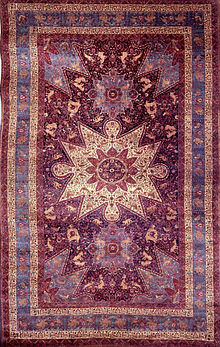
Calvin Coolidge was an American attorney and politician who served as the 30th president of the United States from 1923 to 1929.

A carpet is a textile floor covering typically consisting of an upper layer of pile attached to a backing. The pile was traditionally made from wool, but since the 20th century synthetic fibers such as polypropylene, nylon, or polyester have often been used, as these fibers are less expensive than wool. The pile usually consists of twisted tufts that are typically heat-treated to maintain their structure. The term carpet is often used in a similar context to the term rug, but rugs are typically considered to be smaller than a room and not attached to the floor.
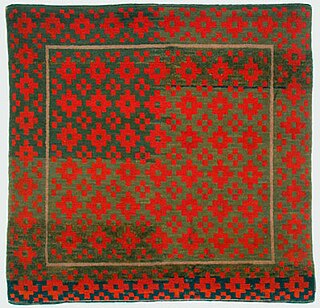
Tibetan rug making is an ancient, traditional craft. Tibetan rugs are traditionally made from Tibetan highland sheep's wool, called changpel. Tibetans use rugs for many purposes ranging from flooring to wall hanging to horse saddles, though the most common use is as a seating carpet. A typical sleeping carpet measuring around 3 ft × 5 ft is called a khaden.

A Persian carpet or Persian rug, also known as Iranian carpet, is a heavy textile made for a wide variety of utilitarian and symbolic purposes and produced in Iran, for home use, local sale, and export. Carpet weaving is an essential part of Persian culture and Iranian art. Within the group of Oriental rugs produced by the countries of the "rug belt", the Persian carpet stands out by the variety and elaborateness of its manifold designs.

A prayer rug or prayer mat is a piece of fabric, sometimes a pile carpet, used by Muslims, some Christians, especially in Orthodox Christianity and some Baha'i during prayer.
An oriental rug is a heavy textile made for a wide variety of utilitarian and symbolic purposes and produced in "Oriental countries" for home use, local sale, and export.
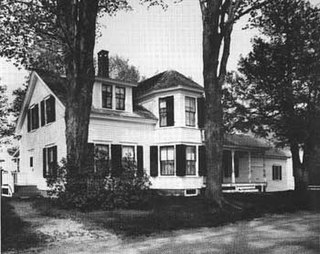
The Coolidge Homestead, also known as Calvin Coolidge Homestead District or President Calvin Coolidge State Historic Site, was the childhood home of the 30th president of the United States, Calvin Coolidge and the place where he first took the presidential oath of office. Located in Plymouth Notch, Vermont, Coolidge lived there from age four in 1876 to 1887, when he departed for Black River Academy for education. He is buried in Plymouth Notch Cemetery not far from the home.

Anatolian rug or Turkish carpet is a term of convenience, commonly used today to denote rugs and carpets woven in Anatolia and its adjacent regions. Geographically, its area of production can be compared to the territories which were historically dominated by the Ottoman Empire. It denotes a knotted, pile-woven floor or wall covering which is produced for home use, local sale, and export, and religious purpose. Together with the flat-woven kilim, Anatolian rugs represent an essential part of the regional culture, which is officially understood as the Culture of Turkey today, and derives from the ethnic, religious and cultural pluralism of one of the most ancient centres of human civilisation.
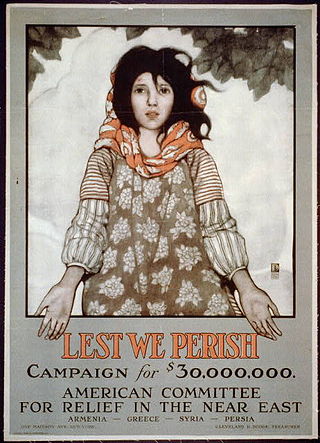
The Near East Foundation (NEF) had its genesis in a number of earlier organizations. As the scope of relief expanded from aid to Greek, Armenian and Assyrian victims of the Ottoman Empire to post-World War I relief in the region, the names and mission changed. The inception was as the American Committee on Armenian Atrocities, followed by American Committee for Armenian and Syrian Relief (ACASR), then American Committee for Relief in the Near East (ACRNE), before becoming Near East Relief in August 1919. In 1930 as the relief work diminished and development work expanded, the organization reorganized as the Near East Foundation.

The President's Dining Room is a dining room located in the northwest corner of the second floor of the White House. It is located directly above the Family Dining Room on the State Floor and looks out upon the North Lawn. The Dining Room is adjacent to the Family Kitchen, a small kitchen designed for use by the First Family, and served by a dumbwaiter connected to the main kitchen on the ground floor.

Arthur T. Gregorian,, was a Greater Boston oriental rug dealer and author of books on oriental rugs. He is considered by some to be the world's leading collector of rare, inscribed Armenian rugs.
Armenian Museum of America (AMA), located in Watertown, Massachusetts, United States, is an institution that has the largest collection of Armenian artifacts in North America.

Aris Luke Alexanian was a noted world traveller, prominent Armenian Canadian and business man. Also, referred to in articles and publications as A. L. Alexanian and Aris L. Alexanian.
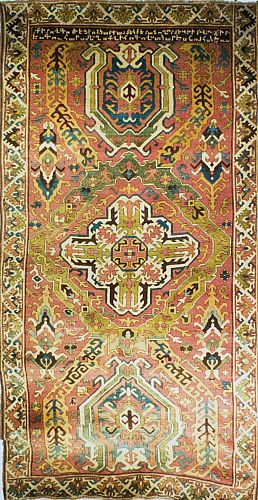
The term Armenian carpet designates, but is not limited to, tufted rugs or knotted carpets woven in Armenia or by Armenians from pre-Christian times to the present. It also includes a number of flat woven textiles. The term covers a large variety of types and sub-varieties. Due to their intrinsic fragility, almost nothing survives—neither carpets nor fragments—from antiquity until the late medieval period.

Azerbaijan National Carpet Museum is a museum located in Baku that displays Azerbaijani carpets and rugs with historical and modern weaving techniques and materials. It has the largest collection of Azerbaijani carpets in the world. First opened on Neftchiler Avenue in 1967, it moved to a new building on the Baku's seafront park in 2014.

On 2 June 1992, the Nagorno-Karabakh Republic (NKR), a former breakaway state in the South Caucasus region, adopted a flag derived from the flag of Armenia, to which a white, five-toothed, stepped carpet pattern is added, beginning at the two verges of the flag's fly and meeting at a point equal to one-third of the distance from that side. The NKR was renamed the Republic of Artsakh in 2017 after a referendum and retained the flag. Following an Azerbaijani offensive on 19 September 2023, Artsakh agreed to dissolve itself by 1 January 2024.
The following events occurred in December 1925:

Hratch Kozibeyokian is an Armenian American distinguished expert of oriental rugs.

The presidency of Calvin Coolidge began on August 2, 1923, when Calvin Coolidge became the 30th president of the United States upon the sudden death of Warren G. Harding, and ended on March 4, 1929.

Shushi Carpet Museum is a museum in Shusha, Azerbaijan. It was founded by Vardan Astsatryan in 2011. The museum opened its doors to the public in 2013, when its location, Shusha, was under the control of the self-proclaimed Republic of Artsakh.
